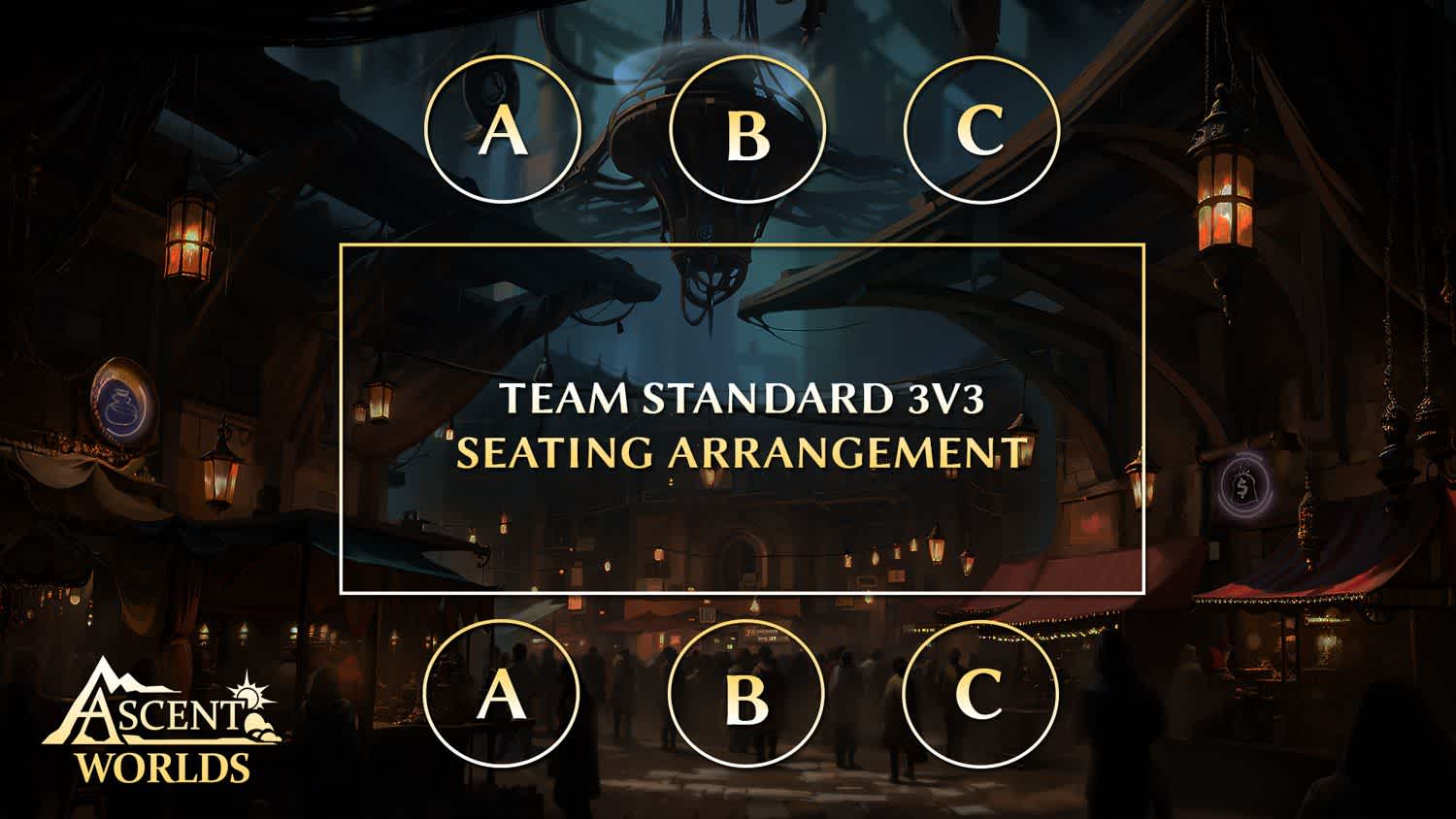RETURN TO ARTICLE LIST
Ascent Worlds: Understanding the Team Standard Format
Written by Noel
Created 14 June, 2025
Last updated 15 June, 2025

Understanding the 3v3 Format For Ascent Worlds
Hey everyone,
With Ascent Worlds coming up at the end of the month, I figured now would be a good time to do a short breakdown of the Team Standard format (also known as 3v3), what to expect, and how to prepare.
How Does Team Standard Work?
Good question! First off, Team Standard is a 3 versus 3 format, rather than a typical tournament where you play 1 versus 1. Each member of the team plays their own matches, but your records are combined together to create the team’s record. That may sound a bit confusing, so let’s dive in to the logistics:
First, pick 2 friends to make up your team. Congrats, the hard part is done! Now, assign each member to be Player A, B, or C (more on this below, but it doesn’t really matter who is which too much), and pick a team name. When you check in for the event, the three of you will all fill out a slip confirming the above details, and your team name will be entered into the event in Omnidex (and the team will be associated to your 3 Omnidex accounts). When the pairings go up, find the table for your team and there’ll be marked spots for Player A, B, and C. Opposing teams do the same; therefore, A plays A, B plays B, and C plays C. You’ll each play a single game of Grand Archive, and whichever team wins 2 of the 3 games wins the match.

During the matches, you’re allowed to talk to the teammates sitting next to you to strategize for your games. This means that C can ask B for advice on if they should play a counterspell or save it for later (but C can’t ask A). We aren’t sure yet if the judges will allow “telephoning” or not, where B passes messages between players A and C; it was an unclear ruling for a lot of the event last year, so they’ll likely make an announcement about it during the player meeting before round 1.
The main quirk of the format is that your team’s decks share the standard deckbuilding restrictions; while each player submits a 12 card material deck and 60+ card maindeck, only 1 copy of any given regalia/champion, and 4 copies of any given main deck card, may be present across all the lists. This means that if Player A registers Backup Charger in their list, neither B nor C can register Backup Charger in their list. If Player B plays 3 Dungeon Guide, and C plays 1 Dungeon Guide, then A cannot play Dungeon Guide.
These 2 rules, bo1 and limited card selection, have a drastic impact on the format. So…
What to Expect?
There’s a lot of weirdness that happens due to these 2 simple rules. No one has a sideboard. Only 1 player gets Backup Charger, Tariff Ring, Safeguard Amulet, Dungeon Guide, or Fast Cure. Only 1 player gets Zander lvl 1.
What does that mean practically? No sideboarding means that reactive decks need to be broader in their types of interaction or play more generically powerful cards. Cards that are blowouts in some matchups, but dead in others, get a lot worse; there’s still value in playing them, but a deck can’t be too inconsistent. A water deck will likely want to play 2x Song of Frost in the mainboard, but not 4. A wind deck might play a lot of 1-2 of’s with maxed out copies of Fairy Whispers and Scout the Lands to filter for specific pieces. This also means that a deck that can get blown out by specific power cards gets a lot stronger, since it’s less likely that the opponent is playing those cards. Which leads into the discussion on limited card selection.
Remember, only 1 player can play a specific regalia. So if you like to play a deck that makes heavy use of the graveyard, like Genbu or Fire Lorraine, there’s only a 1/3 chance that your opponent has a Nullifying Lantern in their deck. If you’re playing a deck like Seiryuu, there’s only a 1/3 chance your opponent is on wind and could play Ensnaring Fumes, but since it’s a pretty matchup specific card, it’s possible they might not even be on any copies at all. This means that a lot of decks that normally get hated out suddenly have a lot more room to breathe.
The next big thing is simply figuring out what 3 decks make a good combination together. It’s not a standard team game where you want synergies between the strategies, but really you’re looking for anti-synergies in a way; when there’s only 4 Dungeon Guides across 3 decks, it’s probably best to give them all to 1 deck, which means the other 2 need to not rely on Dungeon Guide.
How To Prepare
First, talk with your teammates about what decks you’re all comfortable playing, and then look at what cards overlap in your decklists. Start by filtering for the decks with the least overlap, maybe something like Norm Slimes, Fire Zander Aggro, and Genbu. Depending on how competitively driven you all are, you also need to filter for competitively viable decks. Notice I didn’t say meta decks, but “competitively viable.” There’s a big difference there, because remember as I said above, the limited card selection means that a lot of decks get a lot better. Of course, this applies to both meta decks and non-meta decks; while there’s less Nullifying Lanterns to shut off x card, there’s also less phantasia hate and Blanches to limit Fractals.
Now that your team has identified an initial spread of decks you’re comfortable with playing, start testing! Odds are you need to cut some cards from all the decks, so start looking into viable replacements. Some of these are easy, like swapping a Backup C arger to Portentious Tanngu or Windspire Crest, but some aren’t as obvious; last year, we gave Tariff Ring to our Wind Allies deck, but I still wanted a 0 cost defensive regalia in my Water Neos list, so I played Resplendent Kiteshield (and it was surprisingly good!) I recommend taking a look at the list of 3v3 decks that made top 16 last year for some inspiration https://luxerasmap.com/tournaments/ascent-worlds-team-standard-3v3/ .
Frequently Asked Questions
- What if I don’t have any friends going? Check out the official Grand Archive tcg discord (discord.gg/GrandArchiveTCG) and the Merlin’s Marketplace discord (discord.gg/GrandArchive) to find other players in a similar situation. You’d be surprised how many singles are looking for teammates in their area!
- Who should we put in seat B? It doesn’t really matter which deck you put in which seat, so I recommend putting your most observant (and least distractible) player in the middle seat so they can weigh in on all the matches.
- Does asking teammates for help take too much time? Not at all! You have 50 minutes to play a single game, so don’t rush your plays, and don’t hesitate to ask your teammates for their input
- How does Omni count the stats? The event will have a number of "players" equal to the number of teams, so if there's 600 people playing, then it'll be a 200 person event (which is relevant for Event Points). You still gain and lose VP and ELO like normal based on your team's performance
Final Tips
- Games will be pretty RNG heavy; because these are best of 1s, variance plays a much bigger role than it does in a normal GA event. Don’t fixate too heavily on a loss caused by a bad draw or a lucky topdeck.
- Stay hydrated! This doesn’t have anything to do with 3v3, but it’s a good thing to remember.
And that’s all from me for now, looking forward to seeing everyone in Anaheim!